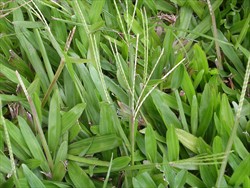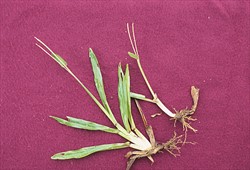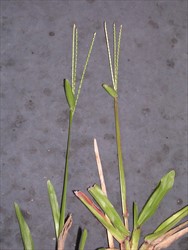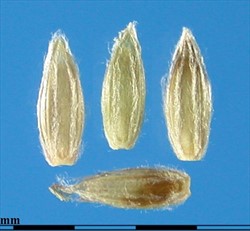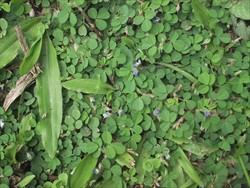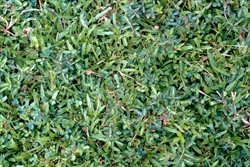Tropical Forages
Axonopus compressus (Sw.) P. Beauv.
Subordinate taxa:
Axonopus compressus (Sw.) P. Beauv. var. jesuitica A.A. Araújo
Axonopus compressus var. compressus
Basionym: Milium compressum Sw.; Axonopus compressus var. australis G. A. Black
Family: Poaceae (alt. Gramineae) subfamily: Panicoideae tribe: Paspaleae subtribe: Paspalinae.
Shallow-rooted stoloniferous and shortly rhizomatous perennial, with glabrous, oval-section (± 3.5 × 2.5 mm) stolon internodes and bearded nodes; forms a dense mat with foliage 15‒20 cm tall, and flowering culms mostly 30‒45 (‒60) cm; can be mowed to a turf. Leaf sheath compressed, keeled, glabrous or ± hirsute; ligule a fringed membrane 0.5 mm long; blades shiny, flat or folded, 4‒18 mm wide, and 2‒16 cm long, glabrous or hairy on the upper surface, margins ciliate, apex broadly acute or obtuse. Inflorescence a panicle comprising 2 or 3 (rarely 5) slender, spikelike racemes, paired or sub-digitately arranged on a long slender peduncle; racemes (2‒) 3‒7 (‒10) cm long; spikelets, 2‒3.5 mm long, 1‒1.25 mm broad, inserted alternately either side of a flattened rachis. 2.6‒3 million seeds per kg.
Similar species
Differs from A. fissifolius in being more stoloniferous and in having stouter culms and stolons, broader leaves, and longer, more acute spikelets.
Asia: 地毯草 di tan cao (China); rumput pahit, papahitan, jukut pahit (Indonesia); tsurume-hishiba (Japan); cow grass, rumput parit (Malaysia); carabao grass, kulape (Philippines); ya baimaln, ya-malaysia (Thailand)
English: American carpet grass, blanket grass, broadleaf carpet grass, carpet grass, Dorrington grass, flat jointgrass, lawn grass, Louisiana grass, tropical carpet grass; savannah grass (West Indies); wide-leaved carpet grass
Europe: buffalo américain, herbe de la Louisiane, herbe gazon (French); Teppichgras (German); assonopo compresso (Italian)
Latin America: capim-bananal, pasto-chato (Brazil); alfombra, grama ancha, grama bahiana, grama brasilera, grama trenza, zacate amargo (Spanish); nudillo (Peru); barbacoa (Venezuela); bes-chaitgras (Suriname); cañamazo dulce (Cuba)
Pacific: kambutu ni vavalangi (Fiji)
Native:
Northern America: Mexico, USA (Alabama, Arkansas (c.), Florida (s.), Georgia (w.-c.), Louisiana (s.), Mississippi (n.e.), South Carolina (s.),Texas (e.))
Caribbean: Antigua and Barbuda, Bahamas, Barbados, Cuba, Dominica, Grenada, Guadeloupe, Hispaniola, Jamaica, Martinique, Puerto Rico, St. Lucia, St. Vincent and Grenadines
Central America: Belize, Costa Rica, El Salvador, Guatemala, Honduras, Nicaragua, Panama
South America: Argentina, Bolivia, Brazil, Colombia, Ecuador, French Guiana, Guyana, Paraguay, Peru, Suriname, Uruguay, Venezuela
Cultivated/naturalized:
Widely naturalized and used as a turf and forage in the humid tropics and subtropics, especially west tropical Africa, South Africa, India, the Philippines, Indonesia, Malaysia, Australia and the Pacific Islands
Forage
Used as a naturalized component of permanent pasture; mostly grazed because generally too low growing to be useful in cut-and-carry systems or for fodder conservation.
Environment
A useful ground cover and turf in moist, low fertility soils, particularly in shaded situations. Provides excellent erosion control due to and facilitates reduced herbicide use when used as soil cover in tree plantations.
Soil requirements
Adapted to well to moderately drained sandy or sandy-loam soils, but also to light clays and peats, flourishing in soils too infertile for Paspalum dilatatum. Best in acid soils with pH (5.0‒) 5.5‒6 (‒7), iron chlorosis above pH 7. Low tolerance of salinity (<4 dS/m).
Moisture
Mostly found in areas with an annual rainfall of (800‒) 1,000‒4,000 (‒5,000) mm. It is not very drought-tolerant, even less so than A. fissifolius. While preferring moist soils, it does not withstand prolonged flooding or permanently swampy conditions.
Temperature
Occurs from sea level to 3,000 m asl, and from near the equator to 27 (‒32)º latitude, representing a significant range in average annual temperatures from (13.5‒) 19 to 27 °C. Although found in the subtropics and upland tropics, it appears to be best adapted to the lowland tropics. Tops are burnt off by frost, but plants recover with the onset of warmer, moist conditions; less frost tolerant than A. fissifolius.
Light
It grows well in the shade, often forming a thick mat under dense tree canopies. It is considered a valuable ground cover under oil palm and rubber plantations.
Reproductive development
A. compressus flowers over a wide range of daylengths, flowering through much of the growing season in most environments.
Defoliation
It thrives under heavy grazing. Frequent grazing also helps to maintain it in a vegetative state.
Fire
Although mostly growing in areas where fire is not a problem, it recovers quickly from fire.
Guidelines for establishment and management of sown forages.
Establishment
Since commercial seed is often not available, is usually propagated vegetatively. When seed is available, it is broadcast onto, or shallowly sown into, a well-prepared seedbed to give the best chance of establishment. Subsequent rolling helps maintain soil moisture and ensures close contact between soil and seed. Choice of sowing rate depends on quality of seedbed and the rate of ground cover required. With a good seedbed, where rate of cover is not an issue, 2‒3 kg/ha of seed is adequate, while with a less well prepared seedbed or where rapid cover is important, 6‒12 kg/ha may be necessary.
Fertilizer
Relatively low amounts of nitrogen can be fixed through non-symbiotic associations in the rhizosphere of . Even so, low rates of nitrogen can help to extend the otherwise fairly short growing season, and to maintain the sward in a vegetative state. It does not appear to be very responsive to phosphorus, growing well in low P soils.
Compatibility (with other species)
As soil nitrogen levels decline and under regular defoliation, A. compressus can successfully invade pastures based on more fertility demanding species such as Paspalum dilatatum, Cynodon dactylon and Setaria sphacelata, particularly if shade levels increase.
Companion species
Grasses: Axonopus fissifolius, Chrysopogon aciculatus.
Legumes: Arachis pintoi, Grona heterophylla, G. triflora, Lotus uliginosus, Trifolium repens, , Vigna parkeri.
Pests and diseases
It is not subject to any major diseases or insect pests, although it is attacked by grass webworm (Herpetogramma licarsisalis; Lepidoptera: Pyralidae), usually during rainy weather, and is an alternative host for Rhizoctonia solani and rice tungro spherical waikavirus.
Ability to spread
It spreads more quickly vegetatively under favourable conditions than , but more slowly by seed, since it is a less prolific seed producer.
Weed potential
It can become a troublesome weed in the wet tropics.
Nutritive value
Forage quality is generally poor, but higher than for . CP level in 3-week regrowth following 100 kg/ha N has been measured at 22.3%, declining to 17.8% at 6 weeks.
Palatability/acceptability
It is slightly more palatable than , but less so than Paspalum dilatatum.
Toxicity
No record of toxicity.
Feedipedia link
Dry matter
Dry matter yields of 1‒5 (‒10) t/ha have been measured.
Animal production
Average daily liveweight gain of about 200 g/hd/day has been measured in steers grazing over an extended period.
2n = 40 (rarely 50 or 60). A cross-pollinating, heterogamous species, forming mostly sterile hybrids with other species in the complex.
Seed can be harvested with a stripper type harvester.
No data, but probably similar to : "Susceptible to DSMA, bentazon, bromoxynil, 2,2-DPA and metsulfuron methyl. Tolerant of diclofop methyl."
- Grows on poor soil.
- Good ground cover.
- Tolerates heavy grazing.
- Very shade tolerant.
- Tolerates poor drainage.
- Poor drought tolerance.
- Low nutritive value.
- Low dry-matter yield.
- Short growing season.
Bogdan, A.V. (1977) Tropical Pasture and Fodder Plants. Longman Inc., New York, USA. p. 45–47.
Evans, D.O., Joy, R.J. and Chia, C.L. (1988) Cover Crops for Orchards in Hawaii. University of Hawaii at Manoa, Honolulu, Hawaii, USA. hdl.handle.net/10125/5989
Gledhill, D. (1966) Cytotaxonomic revision of the Axonopus compressus Sw. Beauv. complex. Boletim da Sociedade Broteriana 40(2nd Ser.):125–147.
Manidool, C. (1992) Axonopus compressus (Sw.) P. Beauv. In: Mannetje, L.’t and Jones, R.M. (eds) Plant Resources of South-East Asia No. 4. Forages. Pudoc Scientific Publishers, Wageningen, the Netherlands. p. 53–54. edepot.wur.nl/327785
Wong, C.C. (1990) Shade Tolerance of Tropical Forages: A Review. In: Shelton, H.M. and Stür, W.W. (eds) Forages for Plantation Crops. Proceedings of a workshop, Sanur Beach, Bali, Indonesia. 27–29 June 1990. ACIAR Proceedings No. 32. Australian Centre for International Agricultural Research (ACIAR), Canberra, Australia. p. 64–69 aciar.gov.au/node/8081
None reported.
